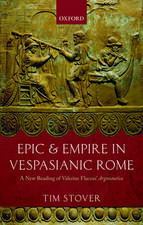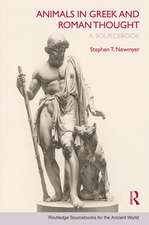The Roman World, 44 BC AD 180: The Routledge History of the Ancient World
Autor Martin Goodmanen Limba Engleză Paperback – 10 noi 2011
Martin Goodman examines the reliance of Roman emperors on a huge military establishment and the threat of force. He analyses the extent to which the empire functioned as a single political, economic and cultural unit and discusses, region by region, how much the various indigenous cultures and societies were affected by Roman rule. The book has a long section devoted to the momentous religious changes in this period, which witnessed the popularity and spread of a series of elective cults and the emergence of rabbinic Judaism and Christianity from the complex world of first-century Judaea. This book provides a critical assessment of the significance of Roman rule for inhabitants of the empire, and introduces readers to many of the main issues currently faced by historians of the early empire.
This new edition, incorporating the finds of recent scholarship, includes a fuller narrative history, expanded sections on the history of women and slaves and on cultural life in the city of Rome, many new illustrations, an updated section of bibliographical notes, and other improvements designed to make the volume as useful as possible to students as well as the general reader.
Preț: 314.57 lei
Nou
60.19€ • 63.01$ • 49.81£
Carte disponibilă
Livrare economică 15-29 martie
Livrare express 01-07 martie pentru 44.15 lei
Specificații
ISBN-10: 0415559790
Pagini: 432
Ilustrații: 45 black & white halftones, 22 black & white line drawings
Dimensiuni: 156 x 234 x 23 mm
Greutate: 0.75 kg
Ediția:Revizuită
Editura: Taylor & Francis
Colecția Routledge
Seria The Routledge History of the Ancient World
Locul publicării:Oxford, United Kingdom
Public țintă
General and UndergraduateCuprins
Part 1: Introduction 1. Sources and problems 2. The Roman world in 50 BC Part 2: Elite politics 3. The political language of Rome 4. Caesar to Augustus, 50 BC-AD 14 5. Julio-Claudians, AD 14-68 6. Civil war and Flavians, AD 68ߝ96 7. Nerva to Marcus Aurelius, AD 96ߝ180 Part 3: The state 8. Military autocracy 9. The operation of the state in Rome 10. The operation of the state in the provinces 11. The army in society 12. The image of the emperor 13. The extent of political unity 14. The extent of economic unity 15. The extent of cultural unity Part 4: Society 16. Reactions to imperial rule 17. The city of Rome: Social organization 18. The city of Rome: Culture and life 19. Italy and Sicily 20. The Iberian Peninsula and the islands of the western Mediterranean 21. Gaul and Britain 22. The Rhineland and the Balkans 23. Greece and the Aegean coast 24. Central and eastern Turkey 25. The northern Levant and Mesopotamia 26. The southern Levant 27. Egypt 28. North Africa Part 5: Humans and gods 29. Religion 30. Judaism 31. Christianity Part 6: Epilogue 32. Severans to Constantine
Notă biografică
Martin Goodman is Professor of Jewish Studies at Oxford. He is a Fellow of Wolfson College, Oxford, and a Fellow of the British Academy. He has written numerous books, including The Ruling Class of Judaea (1987) and Rome and Jerusalem: the clash of ancient civilizations (2007).
Descriere
The Roman World 44 BC ߝ AD 180 deals with the transformation of the Mediterranean regions, northern Europe and the Near East by the military autocrats who ruled Rome during this period. The book traces the impact of imperial politics on life in the city of Rome itself and in the rest of the empire, arguing that, despite long periods of apparent peace, this was a society controlled as much by fear of state violence as by consent.
Martin Goodman examines the reliance of Roman emperors on a huge military establishment and the threat of force. He analyses the extent to which the empire functioned as a single political, economic and cultural unit and discusses, region by region, how much the various indigenous cultures and societies were affected by Roman rule. The book has a long section devoted to the momentous religious changes in this period, which witnessed the popularity and spread of a series of elective cults and the emergence of rabbinic Judaism and Christianity from the complex world of first-century Judaea. This book provides a critical assessment of the significance of Roman rule for inhabitants of the empire, and introduces readers to many of the main issues currently faced by historians of the early empire.
This new edition, incorporating the finds of recent scholarship, includes a fuller narrative history, expanded sections on the history of women and slaves and on cultural life in the city of Rome, many new illustrations, an updated section of bibliographical notes, and other improvements designed to make the volume as useful as possible to students as well as the general reader.


























